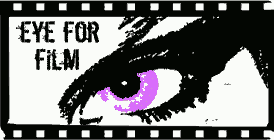David Siegel and Scott McGehee’s wondrous and sage The Friend (spiritedly adapted from the National Book Award-winning novel by Sigrid Nunez and a highlight in the Spotlight programme of the 62nd New York Film Festival) stars Naomi Watts as Iris, an author in New York City who loses her best friend Walter (Bill Murray) to suicide and inherits his majestic Harlequin Great Dane Apollo (played by the scene- and heart-stealing Bing).
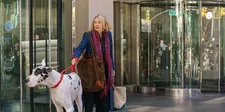 |
| Iris (Naomi Watts) on the streets of New York City with her very large tote bag and Apollo (played by Bing) |
After already having thrown the advice by WC Fields to never work with children or animals to the wind with their beautiful Henry James adaptation What Maisie Knew, Siegel and McGehee fully embrace the tale of a friendship that belies our dominant anthropocentrism. “How can you explain death to a dog?” Iris, as well as the nameless narrator in the Nunez novel know some important truths about animals: “They don’t commit suicide. They don’t weep. But they can and do fall to pieces. They can and do have their hearts broken. They can and do lose their minds.”
“You will see a large chest, standing in the middle of the floor, and upon it a dog seated, with a pair of eyes as large as teacups. But you need not be at all afraid of him.” As in Hans Christian Andersen’s tale The Tinderbox, Iris has to conquer her own fears. She knows how her whole self is at stake when dealing with this big, sad, lovable being who himself has to overcome so much.
Today, March 27, Sigrid Nunez will join David Siegel and Scott McGehee for a conversation following the 6:30pm screening of The Friend inside the Celeste Auditorium of the Stephen A Schwarzman building at 42nd Street & 5th Avenue.
From New York City, David Siegel and Scott McGehee joined me on Zoom for an in-depth conversation on The Friend shortly after their film screened at the New York Film Festival.
David Siegel: Hi!
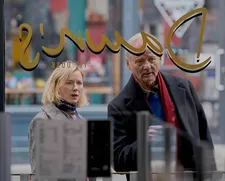 |
| Iris (Naomi Watts) with her dear friend Walter (Bill Murray) |
Anne-Katrin Titze: Hi! Hello! Good to see you both! How was the New York Film Festival for you? Bing and Naomi were the hits of the red carpet!
DS: To see that movie on that screen was really special for us. I mean, it's a very New York movie. And we've been going but we haven't ever had a film at the New York Film Festival. We've never been in the right cycle, or it just has never worked out. So it seemed like the perfect film for us to have there. And it seemed like the audiences were really warm to it.
AKT: It's really super New York, all the locations, all the dog parks are recognizable, and the Farmers’ Market and Lafayette Street and at the beginning the Promenade in Brooklyn. It's very much the spirit of New York.
DS: Yeah, we worked hard for that.
Scott McGehee: It was very much in our mind to make a kind of iconic New York movie. We thought about that as we were working on the script, kind of just where we set things, but also in locations, and even working with the composer on the soundtrack. It was very much something we wanted people to feel, a kind of like old fashioned New York movie that felt sort of familiar and yet something new.
DS: Not really old fashioned, more just having a kind of nostalgic feel to it.
AKT: Because there haven't been that many recently. I mean, there’s Woody Allen pre-scandal.
DS: Which one?
AKT: Right, which one? He had in his movies these spots and places to recognize and immediately set the mood. It hasn't been done that much successfully since, and I think Sigrid Nunez, of course, is perfect for that. For the epigraph in her novel she has three quotes, two of them are about writing and grieving, and the one in the middle is from The Tinderbox. In your film, you took that epigraph and used it in a conversation and have people talk about Hans Christian Andersen and The Tinderbox, didn’t you?
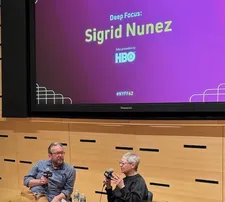 |
| Sigrid Nunez with AO Scott at the 62nd New York Film Film Festival |
DS: We did, yeah.
AKT: It’s brilliant. I love that you did that.
SMG: Thank you very much. Yeah, you know, it's interesting adapting her novel because there are so many little thoughts and tangents and side conversations. And deciding what to include and what to leave out was obviously really a challenge. We love her writing so much.
DS: And have come to love her a lot. She's as seductive a person as her writing is.
AKT: I'm going to talk to her on Monday.
SMG: Oh, yeah, she's great. I'm sure you'll really enjoy it.
DS: She's just a really smart, dynamic, funny, super interesting person.
AKT: How much did you work with Sigrid for the screenplay?
DS: Not at all other than in talking to her. She was a good sounding board. We would discuss what we were going to do, but from the get go she was like, I don't know, I don't know anything about screenwriting. I don't really know anything about movies other than loving them. Go with God! So that was great.
AKT: Let's jump into certain details. For the writing workshop, for example, you made an interesting choice to have Iris, as you named her, sit on the side and not at the table with the students. Did that come from personal experience or did it have to do with shooting the scene?
DS: Movie making is so much a kind of intersection of intention, accident, happenstance. The way that that room laid out… We had to kind of rejigger the schedule three times to be able to accommodate the location that we wanted, and then that location dropped away, and we wound up at Brooklyn College for those classroom scenes. And so then we were trying to figure out how to shoot in that classroom.
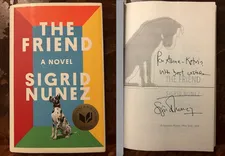 |
| The Friend inscribed by Sigrid Nunez to Anne-Katrin Titze Photo: Anne Katrin Titze |
It was a real kind of lark of an idea. Well, what if? Because the way that the table is configured in the middle of the room, what if she were off rather than being lost, looking out the window from the table? What if she just has removed herself in a kind of distraction because of what's been going on? And then we saw it in the camera, and we thought about it in terms of the way it might work with the sequence, and her coming back to the table to discuss the situation with Carter. It just kind of worked out that way.
AKT: It’s an intriguing choice.
DS: It wasn't written in the script that way.
AKT: As far as the costumes are concerned, Pedro Almodóvar who filmed the other Nunez book in this festival (The Room Next Door), he goes all out with making both women in the center of the story (played by Julianne Moore and Tilda Swinton) really glamorous. You went for cardigans and wildly mismatched patterns, and a very eclectic way of dressing for Naomi Watts. Can you talk a little bit about your choices? Because in the book, there's nothing about what she looks like.
SMG: We spent a lot of time talking with our costume designer Stacey Battat. We've worked with her a couple of times already, and she's got a great eye. The starting place we were going for was really trying to think about how our creative friends actually wear their clothes.
DS: What would a woman, actually a man, too, but especially a woman of Iris's age wear? She would have grown up in the Eighties, right? Even the Eighties into the Nineties when vintage and style was kind of more eclectic that way. What would she have kept with her? What would she have prized? What would have changed? So we felt like we needed to build a kind of wardrobe world for her that matched her history a little bit.
SMG: It shouldn't feel like she thinks about her clothes all the time. That's just not the kind of person we wanted her to be.
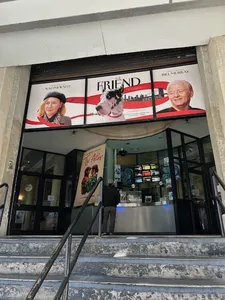 |
| The Friend at the entrance to the Angelika Film Center in New York Photo: Anne Katrin Titze |
DS: And yet she's a person who definitely thinks of herself as having a certain kind of style. And our production designer, Scott's sister, Kelly [McGehee], who has also worked with Stacey on other movies with us, was very involved in that also in terms of the color palette of the clothing and the sets, and that sort of thing.
AKT: I remember we talked about it in the context of What Maisie Knew.
DS: Yeah, those two worked on amazing things.
AKT: The great Maisie animal onesies! I had a brief exchange with Stacey Battat about [Sofia Coppola’s] Priscilla. She's very good at really going deeply into the characters and working out the details of certain themes. For example, the gigantic brown leather bag in The Friend seemed almost like a foreshadowing of the bigness of the dog.
DS: I don't think we thought of that, but I like that a lot!
AKT: Somebody with such a big bag will not be intimidated by a big dog.
SMG: She has a lot of papers to grade and computers to carry, and yup, she's a busy New Yorker.
AKT: That's funny. Let's get to Bing. What an amazing discovery! His two-colored eyes, the way he is reacting or not reacting. He's just a star. How did you find him?
DS: We started working on this movie over six years ago, so soon after the book was published, and that fall we connected with Bill Berloni, our head animal trainer. And with Bill we started a kind of nationwide search for a Harlequin Great Dane. It was through kennel clubs and owner groups and things like that, and we went and saw many different Danes in different parts of the country. In February of 2020 we went to Iowa. Our producing partner, Mike Spreter, had found a connection in Iowa and this dog sounded great, and we went to Iowa, and we met Bing, and after we met Bing, we stopped looking for other Danes, because we really felt like we had found the right dog.
SMG: Remarkably, there was a double for Bing, a dog called Wilder, who's from Chicago. And we found him through similar channels. I think maybe he and Bing are cousins, but they look so much alike, and even have different colored eyes that are on the same side. You know, the same one is blue and the same one is brown. We had Wilder in case Bing couldn't do all the work. We thought, oh, if Bing gets tired, or if Bing gets sick for a day, or if there's something Bing can't do, maybe we'll bring Wilder in. But we never shot Wilder. He was just hanging around waiting for his moment.
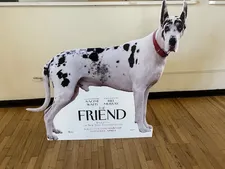 |
| Bing a star in The Friend at the Angelika Film Center Photo: Anne Katrin Titze |
DS: He never got his moment.
SMG: And Bing was on camera every day.
DS: What we thought was our job was in photographing Bing and helping to craft a performance for Bing, was to let Bing be. The way the little girl, in a way, is in What Maisie Knew, Onata Aprile. Bing isn't really representing a dog with particular idiosyncrasies as much as a character going through an emotional experience. So like with actors, when you're looking at Bing's face, do you feel like you're watching him think? When you're watching Naomi Watts think or just gaze off, do you feel like you're watching her think? And you do with Naomi, we believe, and you do with Bing and he really is just a beautiful, soulful wonderful dog.
SMG: And thoughtful, in fact. Like his owner, Bev Klingensmith, she was saying, when she works with Bing. She has other dogs. She's trained them and they're very food focused, and all they think about is like, where's the food? And you can get them to do things because they want the food so bad. But, she said Bing is different, that he wants the food, but really he wants to figure out what you want, like he knows you have something in mind. So she said you could actually kind of see him think: like, okay, last time I sat, that wasn't exactly it. So you were looking for something a little different from me? He’s really trying to work with her. He's unusual that way in her experience.
AKT: Incredible! You said 2020. There's this fantastic line about having missed his entire puppyhood! You knew him when he was little. You got the puppy hood!
SMG: We met him when he was only two. Yeah, sure, one and a half even he was.
DS: He was a little too young for the role.
SMG: We thought he was going to be a little puppyish, like he would play around a little too much.
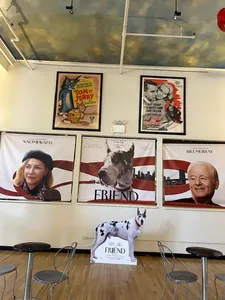 |
| The Friend display at the Angelika Film Center Photo: Anne Katrin Titze |
AKT: You brought up Maisie, the WC Fields quote [“Never work with animals or children.”] is so appropriate for you. You have a little Midnight Cowboy homage in your film as well.
DS: Yeah, we feel the freedom to be slightly juvenile at least once in a movie.
AKT: After seeing the press screening, I wrote to you about the wonderful Blossom Dearie song, sending us off at the end. That's such a great choice. All the music choices are quite playful. You have, I think, the Magic Flute at the beginning, when you first see Bill Murray running, and then, later on, there's some Don Giovanni for the dog, but he prefers the written word!
DS: I'm just curious, did you recognize Blossom Dearie?
AKT: Yes, yes, I did. I love her.
DS: Me too.
SMG: That's a beautiful rendition of that song.
AKT: And it is so New York. Another trend that I found at this year's New York Film Festival is the casting of other directors. Luca Guadagnino had David Lowery and Lisandro Alonso in Queer. You have Tom McCarthy [Dr. Warren]!
DS: We do. I don't know if you'd also noticed, but the person playing the veterinarian [Dr. Novak] is Bruce Norris, the Pulitzer Prize winning playwright.
AKT: I see!
DS: We're trying to up Luca’s game a little bit. Yeah, we thought an Academy Award winner and a Pulitzer Prize winner, I think we raised the bar.
AKT: A little bit. The moment on the boat you chose for the funeral, that was such an incredibly powerful scene, with all the different women, ex-wives in mourning and Bing in the middle. Was it difficult shooting the scene? It looks like it!
DS: Yeah, it was. You know, I think more than children and dogs it’s water! We thought we had plenty of time to shoot that stuff. I think I was more inconsolable at the end of that day, because I wasn't really sure, we weren't really sure if we have the scene. But then we were really happy.
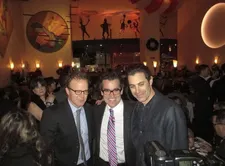 |
| Tom McCarthy (plays Dr. Warren in The Friend) with his Spotlight star Brian d'Arcy James and screenwriter Josh Singer Photo: Anne Katrin Titze |
SMG: It worked out fine. That was a scene that wasn't in the book. That was something that we invented, because we wanted to get out to have that second conversation about Walter, but also we wanted to get out on the water. And we thought that was a nice place to do it there.
DS: We shot it around where we see Walter running at the beginning of the movie, and we wanted to connect those two.
AKT: Did you see Pedro's film?
DS: Yeah, we did. We saw it on Friday night. Yeah, that was really nice to see.
AKT: Because there is a lovely companion piece, parts of the skyline of the different locations in the city. That's really nice.
SMG: No, he managed to get quite a lot of New York in his movie. I think he only shot here for a couple of days, like some of those skylines. I think he managed to do those in a studio with some kind of projection or green screen, or something, but it looks good. You really feel the city quite a lot.
AKT: When I spoke with Alessandro Nivola, he told me that his scene, that powerful scene at the end was all shot in Madrid. Is there a dog coming in?
DS: That's my little dog.
AKT: Apropos little dog, there was an interesting moment when I couldn't really figure out what you were doing. I'm speaking a little in code not to give it away. The dachshund scene where Bill Murray is walking around with daffodils. He is constantly in motion, moving the daffodils and finding different spots for them. Did I miss something? Is there a special reason?
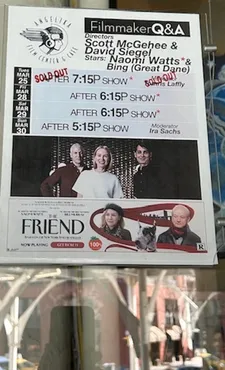 |
| The Friend Q&As at the Angelika Film Center Photo: Anne Katrin Titze |
DS: May I ask you, how did you read it?
AKT: Well in reference to the book, it is the moment that introduces another level. It could be seen as a marker that fiction was what we had seen before. The way you were filming it, it felt as though his looking for the perfect daffodil spot is in a way related to you trying to find a place to fit this shift into the film, this part that speaks of another layer of reality.
DS: I like the way you put that.
SMG: I like that.
DS: It's such a formal scene, like she's brought him back to life in order to kind of take him to task for this thing that he's done. But it kind of gets out of hand for her. It's as if her imagination gets the best of her. And we just thought about adding that kind of formal structure to it because each time that he moves those daffodils it's an inflection point in what she's trying to get at with him. Her creation of him is kind of destabilizing her own imagination in a way. So it's just a way to create several schisms within the scene.
AKT: That's interesting. Also the fact that it's daffodils. Flowers are also prominent in Pedro's movie. The flowers, the snapdragons are jumping at you. It’s life, but life already cut.
DS: Oh, yeah, right.
AKT: Life already wilting but beautiful. That's where I went.
SMG: I love the gladioli behind you, by the way. They're really nice.
AKT: I just got them today.
SMG: I haven't seen gladioli in a while. They're really beautiful.
AKT: They are. In several places in Europe, they have fields of gladioli and you can just stop the car and put money in a box, and take them yourself.
DS: And just take them, wow, nice!
AKT: They are at the Farmers Market at Union Square right now. That scene from It's a Wonderful Life - Sigrid Nunez's books are always full of references that are organically included in her fiction. They are always meaningful, never name dropping, always with a very precise connection. The It's A Wonderful Life scene with the two of them on the bed watching is a great moment.
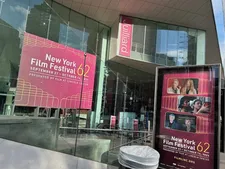 |
| New York Film Festival 62 posters outside Alice Tully Hall Photo: Anne Katrin Titze |
SMG: No, it's interesting, that's a movie that we all grow up with. You know, it’s screened on television year after year in my childhood. And it's a movie I love. I mean, my mother has dementia and we watched it together recently. And it's one of the few movies that she can still really enjoy because she knows it by heart. It's so deeply part of our psyche. But that said, I think it never occurred to me that suicide is the theme of the movie, until reading Sigrid's book and thinking about it in relation to our film. It was so kind of alarming that this Christmas movie feels like it's got so many layers, but how in my own imagination, somehow, it wasn't a suicide film exactly, and yet it is.
AKT: I think many people would agree with you.
SMG: It’s a real interesting trick, right?
AKT: It's one of those films that you think you know, and then when re-watching, you see so much more in it.
DS: They talk about Jimmy Stewart's life as an actor before the war and then after the war, because during the war he was a bomber pilot. He flew really dangerous missions in World War II, and it changed him dramatically. He saw a lot of death in World War II and there's a lot of pictures that he made after World War II where the dark side of Jimmy Stewart shows. It gets pretty dark in It's a Wonderful Life at times.
AKT: Pottersville - look at what it looks like! It all happened this way.
DS: Yeah, probably so, yeah.
AKT: That's where we are. We live in Pottersville.
SMG: Yeah, I'm afraid.
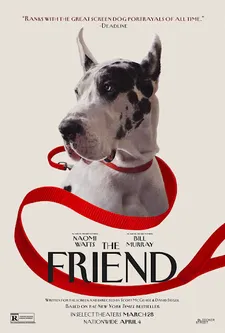 |
| The Friend poster |
AKT: Are you working on a new project?
DS: We are. We're not exactly sure yet. But yeah, we're hoping to be able to shoot a movie next year [2025].
AKT: Any dogs or children?
DS: There are no dogs or children.
AKT: What about water?
DS: Yeah, no water.
SMG: There could be some water, but we'll see.
AKT: It's always great to reconnect!
DS: Yeah, likewise
SMG: Thank you for reaching out! Nice talking to you.
DS: Really appreciate it! A pleasure to talk.
The Friend opens across the US on Friday, March 28. David Siegel, Scott McGehee, Naomi Watts, and Bing will participate in Q&As following the 6:15pm screenings on Friday, March 28 and Saturday, March 29, and on Sunday, March 30 after the 5:15pm show at the Angelika Film Center in New York.
